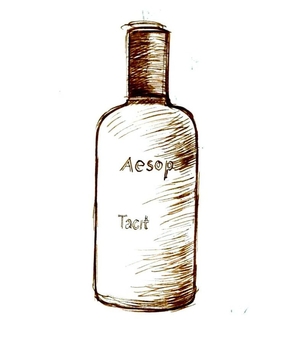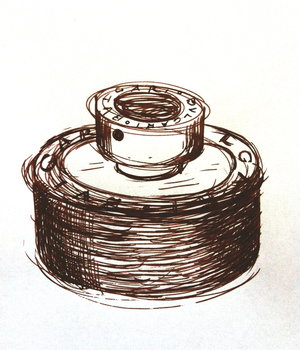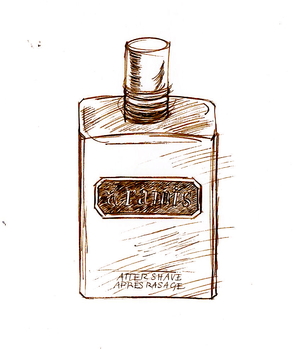Tagged With ‘IFF’
Aesop
Tacit
21 August, 2015
 Launching worldwide in September, Tacit will only be Aesop’s second perfume (if you don’t count the long-discontinued Marrakech and Mystra), but this being Aesop there won’t be lots of razzmatazz. Everyone’s favourite Australian skincare brand likes to do things quietly, and Tacit – which means what’s left unsaid – captures the essence of Aesop pretty well.
Launching worldwide in September, Tacit will only be Aesop’s second perfume (if you don’t count the long-discontinued Marrakech and Mystra), but this being Aesop there won’t be lots of razzmatazz. Everyone’s favourite Australian skincare brand likes to do things quietly, and Tacit – which means what’s left unsaid – captures the essence of Aesop pretty well.
Created by New York-based International Flavors & Fragrances perfumer Céline Barel, Tacit is a subdued take on a classic eau de cologne, though with the grapefruit-like Japanese yuzu replacing eau de cologne’s usual lemony opening, and basil leaves taking the place of rosemary and lavender in its herbaceous heart.
The result is a fresh, unsweetened unisex scent, with a touch of the sour vermouth dryness of Haitian vetiver, extracted from the root of a tropical grass. But this is no ordinary vetiver: instead Barel has used IFF-LMR’s trademarked Vetiver Heart – a cleverly smoothed-out version of traditional vetiver oil, using hydro distillation followed by fractional distillation to extract its usual earthy smell, leaving its slightly bitter dryness intact.
Tacit comes as a 50ml Eau de Parfum (the fragrance industry’s slightly vague term for a solution containing around 10-20 per cent pure perfume) in Aesop’s standard brown glass bottles, but despite the concentration it doesn’t outstay its welcome; in fact personally I’d like it to last a bit longer. The packaging is rather more extravagant: a slim card box decorated by Australian artist Jonathan McCabe, which nestles inside a chunkier brown box, lidded with a card, which in turn slides inside a brown card sleeve.
Tacit is unlikely to turn heads on the street, but that’s not what Aesop’s about: it’s sexy but well-mannered and discreet, which pretty much sums up the brand.
Bulgari
Black
10 July, 2015
 One of the problems with perfume is that there are far too many to choose from. Every year brings more new launches than the year before, and every year the choice becomes more bewildering.
One of the problems with perfume is that there are far too many to choose from. Every year brings more new launches than the year before, and every year the choice becomes more bewildering.
Yet look (or rather smell) more carefully and it soon becomes clear that the vast majority of scents smell boringly similar to each other. Perfume companies on the whole like to play it safe, since it costs a lot of money to launch a new one and failure can be very costly.
So you can bet your bottom dollar that the minute a new fragrance starts to sell really well, a hundred imitations will start appearing on the shelves. Of course it could all be coincidence, or something in the air, but it’s amazing how many perfumes smell virtually identical, even when their branding and their marketing is poles apart. (Want to do a little experiment? OK, follow my friend Roja Dove’s suggestion and try comparing Angel Men with Bleu de Chanel…)
Yet once in a while a really new fragrance does come along, something that stands out from the crowd. Some of them go on to become best-sellers; others don’t. Some of them are crowd-pleasers. Others are wonderful but weird. And few are weirder or more wonderful than Bulgari Black.
Launched in 1998, this was Bulgari’s first perfume for men. It was created by a very talented perfumer called Annick Menardo, who works for the multinational fragrance company, IFF. Now, I’m not a great believer in that tired old cliché that scents can transport you instantly back to a specific moment in your childhood or the like, but the first time I smelled Bulgari Black that’s exactly what happened to me.
I wasn’t transported back to my mother’s knee, though, or to the smell of laundry on a winter’s day. Bulgari Black took me somewhere far more interesting: to the toxic but weirdly sexy 1970s smell that greeted you when you opened the door of a car that had been sitting for too long in the summer sun – of hot PVC, of black plastic car seats that stuck to your legs when you got in.
I think it’s an amazing perfume: the olfactory equivalent of a Helmut Newton photo-shoot, simultaneously erotic and slightly repellent, though I’m still not sure I could actually wear it. But for anyone who loves fast cars and the smell of burning tyres then maybe this is the perfume for you.
Aramis
Aramis
13 September, 2014
 Snobbery seeps into most areas of life, including perfume, and it’s never a very attractive trait, though it’s something that most of us have been afflicted by at one time or another – at least until we learn better.
Snobbery seeps into most areas of life, including perfume, and it’s never a very attractive trait, though it’s something that most of us have been afflicted by at one time or another – at least until we learn better.
As our knowledge of perfume grows, a lot of us get a bit embarrassed about the mass-market fragrances we might once have liked. In some cases that’s fair enough: I don’t imagine that, if I went back and smelled the M&S aftershave I was given for a teenage birthday, I would think ‘wow, what a fantastic example of the perfumer’s art’. On the other hand, by turning our backs on popular perfumes we risk throwing out the Brut with the bathwater.
Aramis illustrates this danger very well. It might have been around as long as anyone can remember. It might (at least until fairly recently) have been as cheap as chips. It might not have come in the most stylish bottle, or the most alluring packaging. Yet it’s actually a wonderful, sexy, high-quality fragrance, which deserves its place on any perfume-lover’s (cool, dark) shelf.
Aramis was launched in 1964, the same year as the original Brut for Men. The first perfume in Estée Lauder’s all-male range of fragrances and skincare, it came to Britain in 1965, and at first was sold exclusively in Harrods – which just shows you images can change.
It was created by one of the finest perfumers of the time, Bernard Chant, who worked for the perfume multinational, International Flavors and Fragrances (IFF), and died in 1987. Chant made his name with the women’s perfume, Cabochard, which was launched in 1959. Combining the dry, leathery smell of isobutyl quinolene with bitter orange, jasmine, ylang-ylang, and various kinds of spice, it was a powerful, confident scent, and quickly became a best-seller – though it has been repeatedly reformulated since, so today’s Cabochard bears little or no resemblance to the original.
I mention Cabochard at some length because, when Chant came to create Aramis for Men, it seems he simply (as far as anything is simple in perfumery) adapted the formula for Cabochard, taking some of the floweriness out and emphasising its leathery-woodiness. The result is an equally punchy fragrance with lots of depth, but just enough rough-edged masculinity (including the sharp spicy-sweaty smell of cumin) to make it appealing to the stubbliest of men.
Aramis is spicy, sweet and long-lasting, and though its spiciness initially made me think of Chanel’s Egoïste, a quick comparison reveals that the latter is much more floral, with a strong dose of vanilla that Aramis lacks. If it doesn’t smell as unusual as some of the men’s perfumes I love, that’s as much as anything to do that it has been around for so long that we’ve since smelled lots of cheap copies, making it seem less original than it actually was in its time.
Bernard Chant went on to create a number of other fine perfumes for Estée Lauder’s various brands, including Azurée (1969) and the well-known Aromatics Elixir (1971), as well as the men’s fragrances Aramis 900 (1973, reviewed here), Devin (1978) and JHL (1981), which were repackaged and relaunched in 2009. They’re all worth exploring, and there’s nothing about them to be snobbish about.